Genetic Variations and Expansion of the Blue Swimmer Crab (Portunus pelagicus) in Southeast Asia
Abstract
1. Introduction
2. Materials and Methods
2.1. Sample Collection
2.2. DNA Extraction, PCR, and Sequencing
2.3. Analyses of Sequences
3. Results
4. Discussion
5. Conclusions
Author Contributions
Funding
Institutional Review Board Statement
Informed Consent Statement
Data Availability Statement
Acknowledgments
Conflicts of Interest
References
- Lai, J.C.Y.; Ng, P.K.L.; Davie, P.J.F. A revision of the Portunus pelagicus (Linnaeus, 1758) species complex (Crustacea: Brachyura: Portunidae), with the recognition of four species. Raffles Bull. Zool. 2010, 58, 199–237. [Google Scholar]
- Huang, Y.H.; Shih, H.T. Diversity in the Taiwanese swimming crabs (Crustacea: Brachyura: Portunidae) estimated through DNA barcodes, with descriptions of 14 new records. Zool Stud. 2021, 60, 60. [Google Scholar]
- Becker, B.J.; Levin, L.A.; Fodrie, F.J.; McMillan, P.A. Complex larval connectivity patterns among marine invertebrate populations. Proc. Natl. Acad. Sci. USA 2007, 104, 3267–3272. [Google Scholar] [CrossRef] [PubMed]
- Zhou, S.; Smith, A.D.; Knudsen, E.E. Ending overfishing while catching more fish. Fish Fish. 2015, 16, 716–722. [Google Scholar] [CrossRef]
- Hillis, D.M.; Moritz, C.; Mable, B.K. Molecular Systematics, 1st ed.; Sinauer Associates Publishers Inc.: Sunderland, MA, USA, 1996. [Google Scholar]
- Excoffier, L.; Smouse, P.E.; Quattro, J.M. Analysis of molecular variance inferred from metric distances among DNA haplotypes: Application to human mitochondrial DNA restriction data. Genetics 1992, 131, 479–491. [Google Scholar] [CrossRef] [PubMed]
- Rogers, A.R.; Harpending, H. Population growth makes waves in the distribution of pairwise genetic differences. Mol. Biol. Evol. 1992, 9, 552–569. [Google Scholar]
- Fu, Y.X. Statistical tests of neutrality of mutations against population growth, hitchhiking and background selection. Genetics 1997, 147, 915–925. [Google Scholar] [CrossRef]
- Pauly, D.; Christensen, V.; Guénette, S.; Pitcher, T.J.; Sumaila, U.R.; Walter, C.J.; Watson, R.; Zeller, D. Towards Sustainability in World Fisheries. Nature 2002, 418, 689–695. [Google Scholar] [CrossRef]
- Hellberg, M.E. Dependence of gene flow on geographic distance in two solitary corals with different larval dispersal capabilities. Evolution 1996, 50, 1167–1175. [Google Scholar] [CrossRef]
- Chai, C.J.; Bin Esa, Y.; Ismail, S.; Kamarudin, M.S. Population Structure of the Blue Swimmer Crab Portunus pelagicus in Coastal Areas of Malaysia Inferred from Microsatellites. Zool Stud. 2017, 16, 56.e26. [Google Scholar]
- Madduppa, H.; Martaulina, R.; Zairion, Z.; Renjani, R.M.; Kawaroe, M.; Anggraini, N.P.; Subhan, B.; Verawati, I.; Sani, L.M. Genetic population subdivision of the blue swimming crab (Portunus pelagicus) across Indonesia inferred from mitochondrial DNA: Implication to sustainable fishery. PLoS ONE 2021, 16, e0240951. [Google Scholar] [CrossRef]
- Haye, P.A.; Segovia, N.I.; Munoz-Herrera, N.C.; Galvez, F.E.; Martinez, A.; Meynard, A.; Pardo-Gandarillas, M.C.; Poulin, E.; Faugeron, S. Phylogeographic structure in benthic marine invertebrates of the southeast Pacific coast of Chile with differing dispersal potential. PLoS ONE 2014, 9, e88613. [Google Scholar] [CrossRef] [PubMed]
- Palumbi, S.R. Molecular biogeography of the Pacific. Coral Reefs 1997, 16, S47–S52. [Google Scholar] [CrossRef]
- Benzie, J.A.H. Genetic structure of coral reef organisms: Eghosts of dispersal past. Am. Zool. 1999, 39, 131–145. [Google Scholar] [CrossRef]
- Briggs, J.S. Coincident biogeographic patterns: Indo-West Pacific Ocean. Evolution 1999, 53, 326–335. [Google Scholar] [CrossRef]
- Benzie, J.A.H.; Williams, S.T. Genetic structure of giant clam (Tridacna maxima) populations in the West Pacific is not consistent with dispersal by present-day ocean currents. Evolution 1997, 51, 768–783. [Google Scholar]
- Palumbi, S.R. Genetic divergence, reproductive isolation, and marine speciation. Annu. Rev. Ecol. Syst. 1994, 25, 547–572. [Google Scholar] [CrossRef]
- Pawson, M.G.; Jennings, S. A critique of methods for stock identification in marine captured fisheries. Fish. Res. 1996, 25, 203–217. [Google Scholar] [CrossRef]
- Chen, P.C.; Shih, C.H.; Chu, T.J.; Lee, Y.C.; Tzeng, T.D. Phylogeography and genetic structure of the oriental river prawn Macrobrachium nipponense (Crustacea: Decapoda: Palaemonidae) in East Asia. PLoS ONE 2017, 12, e0173490. [Google Scholar] [CrossRef]
- Held, C.; Koenemann, S.; Schubart, C.D. Phylogeography and Population Genetics in Crustacea; CRC Publishers Inc.: Boca Raton, FL, USA, 2016. [Google Scholar]
- Yang, C.P.; Li, H.X.; Li, L.; Yan, Y. Occurrence and effects of the rhizocephalan parasite Diplothylacus sinensis (Cirripedia: Rhizocephala: Thomsoniidae) in the swimming crab Portunus sanguinolentus (Decapoda: Portunidae) in Honghai Bay, South China Sea. J. Crustacean Biol. 2014, 34, 573–580. [Google Scholar] [CrossRef][Green Version]
- Tzeng, T.D. Stock identification of sword prawn (Parapenaeopsis hardwickii) in the East China Sea and Taiwan Strait inferred by morphometric variation. Fish Sci. 2004, 70, 758–764. [Google Scholar] [CrossRef]
- Tzeng, T.D. Population structure of the sword prawn (Parapenaeopsis hardwickii) (Decapoda: Penaeidae) in the East China Sea and waters adjacent to Taiwan inferred from the mitochondrial control region. Zool. Stud. 2007, 46, 561–568. [Google Scholar]
- Wu, C.; Kraft, P.; Zhai, K.; Chang, J.; Wang, Z.; Li, Y. Genome-wide association analyses of esophageal squamous cell carcinoma in Chinese identify multiple susceptibility loci and gene-environment interactions. Nat. Genet. 2012, 44, 1090. [Google Scholar] [CrossRef] [PubMed]
- Fratini, S.; Ragionieri, L.; Cannicci, S. Stock structure and demographic history of the Indo-West Pacific mud crab Scylla serrata. Estuarine Coast. Shelf Sci. 2010, 86, 51–61. [Google Scholar] [CrossRef]
- Chu, T.J.; Wang, D.; Haung, H.L.; Lin, F.J.; Tzeng, T.D. Genetic variations and expansion of whiskered velvet shrimp (Metapenaeopsis barbata) off China and Taiwan inferred from intron sequence. Biochem. Syst. Ecol. 2011, 39, 520–525. [Google Scholar] [CrossRef]
- Chu, T.J.; Wang, D.; Huang, H.L.; Lin, F.J.; Tzeng, T.D. Population structure and historical demography of the whiskered velvet shrimp (Metapenaeopsis barbata) off China and Taiwan inferred from the mitochondrial control region. Zool. Stud. 2012, 51, 99–107. [Google Scholar]
- Ma, H.Y.; Ma, C.Y.; Ma, L.B. Population genetic diversity of mud crab (Scylla paramamosain) in Hainan Island of China based on mitochondrial DNA. Biochem. Syst. Ecol. 2011, 39, 434–440. [Google Scholar] [CrossRef]
- Han, Z.Q.; Zhu, W.B.; Zheng, W.; Li, P.F.; Shui, B.O. Significant genetic differentiation between the Yellow Sea and East China Sea populations of cocktail shrimp Trachypenaeus curvirostris revealed by the mitochondrial DNA COI gene. Biochem. Syst. Ecol. 2015, 59, 78–84. [Google Scholar] [CrossRef]
- Chen, P.C.; Shih, C.H.; Chu, T.J.; Wang, D.; Lee, Y.C.; Tzeng, T.D. Population Structure and Historical Demography of the Oriental River Prawn (Macrobrachium nipponense) in Taiwan. PLoS ONE 2015, 10, e0145927. [Google Scholar] [CrossRef]
- Grosberg, R.K.; Cunningham, C.W. Genetic Structure in the Sea: From Populations to Communities. In Marine Community Ecology; Bertness, M.D., Gaines, S.D., Hay, M.E., Eds.; Sinauer Associates Publishers Inc.: Sunderland, MA, USA, 2001; pp. 61–84. [Google Scholar]
- Gallagher, S.J.; Kitamura, A.; Iryu, Y.; Itaki, T.; Koizumi, I.; Hoiles, P.W. The Pliocene to recent history of the Kuroshio and Tsushima Currents: A multi-proxy approach. Prog. Earth Planet. Sci. 2015, 2, 2–17. [Google Scholar] [CrossRef]
- Wang, L.; Sarnthein, M.; Erlenkeuser, H.; Grimalt, J.; Grootes, P.; Heilig, S.; Ivanova, E.; Kienast, M.; Pelejero, C.; Pflaumann, U. East Asian monsoon climate during the late Pleistocene: High-resolution sediment records from the South China Sea. Mar. Geol. 1999, 156, 245–284. [Google Scholar] [CrossRef]
- Hansen, J.E.; Sato, M. Paleoclimate implications for human-made climate change. In Climate Change: Inferences from Paleoclimate and Regional Aspects; Berger, A., Mesinger, F., Sijacki, D., Eds.; Springer Publishers Inc.: New York, NY, USA, 2012. [Google Scholar]
- Li, Y.; Chen, J.; Jiang, L.; Qiao, G. Islands conserve high species richness and areas of endemism of Hormaphidinae aphids. Curr. Zool. 2017, 63, 623–632. [Google Scholar] [CrossRef] [PubMed]
- Shen, K.N.; Jamandre, B.W.; Hsu, C.C.; Tzeng, W.N.; Durand, J.D. Plio-Pleistocene sea level and temperature fluctuations in the northwestern Pacific promoted speciation in the globally-distributed fathead mullet Mugil cephalus. BMC Evol. Biol. 2011, 11, 83. [Google Scholar] [CrossRef] [PubMed]
- Dall, W.; Hill, B.J.; Rothlisberg, P.C.; Staples, D.J. The biology of the Penaeidae. In Advances in Marine Biology; Blaxter, J.H.S., Southward, A.J., Eds.; Academic Press: San Diego, CA, USA, 1990. [Google Scholar]
- Dodd, R.S.; Afzal-Rafii, Z. Evolutionary genetics of mangroves: Continental drift to recent climate change. Trees 2002, 16, 80–86. [Google Scholar] [CrossRef]
- Duke, N.C.; Lo, E.; Sun, M. Global distribution and genetic discontinuities of mangroves—Emerging patterns in the evolution of Rhizophora. Trees 2002, 16, 65–79. [Google Scholar] [CrossRef]
- Ren, G.; Miao, G.; Ma, C.; Lu, J.; Yang, X.; Ma, H. Genetic structure and historical demography of the blue swimming crab (Portunus pelagicus) from southeastern sea of China based on mitochondrial COI gene. Mitochondrial DNA Part A 2018, 29, 192–198. [Google Scholar] [CrossRef]
- McMillen-Jackson, A.L.; Bert, T.M. Disparate patterns of population genetic structure and population history in two sympatric penaeid shrimp species (Farfantepenaeus aztecus and Litopenaeus setiferus) in the eastern United States. Mol. Ecol. 2003, 12, 2895–2905. [Google Scholar] [CrossRef]
- McMillen-Jackson, A.; Bert, T. Mitochondrial DNA variation and population genetic structure of the blue crab Callinectes sapidus in the eastern United States. Mar. Biol. 2004, 145, 769–777. [Google Scholar] [CrossRef]
- Gallagher, J.; Finarelli, J.A.; Jonasson, J.P.; Carlsson, J. Mitochondrial D-loop DNA analyses of Norway lobster (Nephrops norvegicus) reveals genetic isolation between Atlantic and East Mediterranean populations. J. Mar. Biol. Assoc. UK 2019, 99, 933–940. [Google Scholar] [CrossRef]
- Voris, H.K. Maps of Pleistocene sea levels in Southeast Asia: Shorelines, river systems and time durations. J. Biogeogr. 2000, 27, 1153–1167. [Google Scholar] [CrossRef]
- Sambrook, J.; Russell, D.W. Molecular Cloning: A Laboratory Manual, 3rd ed.; Cold Spring Harbor Publishers Inc.: New York, NY, USA, 2001. [Google Scholar]
- Rozas, J.; Sanchez-Delbarrio, J.C.; Messeguer, X.; Rozas, R. DnaSP, DNA polymorphism analyses by the coalescent and other methods. Bioinformatics 2003, 19, 2496–2497. [Google Scholar] [CrossRef] [PubMed]
- Nei, M. Molecular Evolutionary Genetics, 1st ed.; Columbia Publishers Inc.: New York, NY, USA, 1987. [Google Scholar]
- Tamura, K.; Peterson, D.; Peterson, N.; Stecher, G.; Nei, M.; Kumar, S. MEGA6: Molecular evolutionary genetics analysis using maximum likelihood, evolutionary distance, and maximum parsimony methods. Mol. Biol. Evol. 2011, 28, 2731–2739. [Google Scholar] [CrossRef] [PubMed]
- Bandelt, H.J.; Forster, P.; Rohl, A. Median-joining networks for inferring intraspecific phylogenies. Mol. Biol. Evol. 1999, 16, 37–48. [Google Scholar] [CrossRef]
- Nei, M.; Tajima, F. DNA polymorphism detectable by restriction endonucleases. Genetics 1981, 97, 145–163. [Google Scholar] [CrossRef] [PubMed]
- Excoffier, L.; Lischer, H.E. Arlequin suite ver. 3.5: A new series of programs to perform population genetics analyses under Linux and Windows. Mol. Ecol. Resour. 2010, 10, 564–567. [Google Scholar] [CrossRef] [PubMed]
- Tzeng, T.D.; Yeh, S.Y.; Hui, C.F. Population genetic structure of the kuruma prawn (Penaeus japonicus) in East Asia inferred from mitochondrial DNA sequences. ICES J. Mar. Sci. 2004, 61, 913–920. [Google Scholar] [CrossRef]
- Stanley, H.F.; Casey, S.; Carnahan, J.M.; Goodman, S.; Harwood, J.; Wayne, K. Worldwide patterns of mitochondrial DNA differentiation in the harbor seal (Phoca vitulina). Mol. Biol. Evol. 1996, 13, 368–382. [Google Scholar] [CrossRef]
- Tajima, F. Statistical method for testing the neutral mutation hypothesis by DNA polymorphism. Genetics 1989, 123, 585–595. [Google Scholar] [CrossRef]
- Tzeng, T.D.; Chu, T.J.; Wang, D.; Haung, H.L.; Yeh, S.Y. Population Structure in the Sword Prawn (Parapenaeopsis Hardwickii) from the East China Sea and Taiwan Strait Inferred from Intron Sequences. J. Crust. Biol. 2008, 28, 234–239. [Google Scholar] [CrossRef]
- Sezmiş, E. The Population Genetic Structure of Portunus pelagicus in Australian Waters; Murdoch University Publishers Inc.: Filosopi, Australia, 2004. [Google Scholar]
- Chan, B.K.K.; Tsang, L.M.; Chu, K.H. Morphological and genetic differentiation of the acorn barnacle Tetraclita squamosa (Crustacea, Cirripedia) in East Asia and description of a new species of Tetraclita. Zool. Scr. 2007, 36, 79–91. [Google Scholar] [CrossRef]
- Wong, K.J.H.; Chan, B.K.K.; Shih, H.T. Taxonomy of the sand bubbler crabs Scopimera globosa De Haan, 1835, and S. tuberculata Stimpson, 1858 (Crustacea: Decapoda: Dotillidae) in East Asia with description of a new species from the Ryukyus, Japan. Zootaxa 2010, 2345, 43–59. [Google Scholar] [CrossRef]
- Tsang, L.M.; Wu, T.H.; Shih, H.T.; Williams, G.A.; Chu, K.H.; Chan, B.K.K. Genetic and morphological differentiation of the Indo-West Pacific intertidal barnacle Chthamalus malayensis. Integr. Comp. Biol. 2012, 52, 388–409. [Google Scholar] [CrossRef] [PubMed]
- Crandall, K.A.; Templeton, A.R. Empirical tests of some predictions from coalescent theory with applications to intraspecific phylogeny reconstruction. Genetics 1993, 134, 959–969. [Google Scholar] [CrossRef] [PubMed]
- Chiang, T.Y.; Schaal, B.A. Phylogeography of North American populations of the moss species Hylocomium splendens based on the nucleotide sequence of internal transcribed spacer 2 of nuclear ribosomal DNA. Mol. Ecol. 1999, 8, 1037–1042. [Google Scholar] [CrossRef]
- Wang, J.P.; Hsu, K.C.; Chiang, T.Y. Mitochondrial DNA phylogeography of Acrossocheilus paradoxus (Cyprinidae) in Taiwan. Mol. Ecol. 2000, 9, 1483–1494. [Google Scholar] [CrossRef]
- Hu, J.; Kawamura, H.; Hong, H.; Qi, Y. A Review on the currents in the South China Sea: Seasonal circulation, South China Sea warm current and Kuroshio intrusion. J. Oceanogr. 2000, 56, 607–624. [Google Scholar] [CrossRef]
- Yap, E.S.; Sezmis, E.; Chapin, J.A.; Potter, I.C.; Spencer, P.B.S. Isolation and characterization of micro satellite loci in Portunus pelagicus (Crustacea: Portunidae). Mol. Ecol. Notes. 2002, 2, 30–32. [Google Scholar] [CrossRef]
- Smith, G.S.; Sumpton, W.D. Behaviour of the commercial sand crab Portunus pelagicus (L.) at trap entrances. Asian Fish Sci. 1989, 3, 101–113. [Google Scholar]
- Sumpton, W.D.; Potter, M.A.; Smith, G.S. Reproduction and growth of the Commercial Sand Crab, Portunus pelagicus (L.) in Moreton Bay, Queensland. Asian Fish Sci. 1994, 7, 103–113. [Google Scholar]
- Kangas, M.I. Synopsis of the Biology and Exploitation of the Blue Swimmer Crab, Portunus pelagicus Linnaeus, in Western Australia; Fisheries Research Report No. 121; Fisheries Western Australia: Perth, Australia, 2000; pp. 1–22. [Google Scholar]
- Abdul Halim, S.A.A.; Othman, A.S.; Akib, N.A.M.; Jamaludin, N.A.; Esa, Y.; Nor, S.A.M. Mitochondrial markers identify a genetic boundary of the Green Tiger Prawn (Penaeus semisulcatus) in the Indo-Pacific Ocean. Zool. Stud. 2021, 60, e8. [Google Scholar]
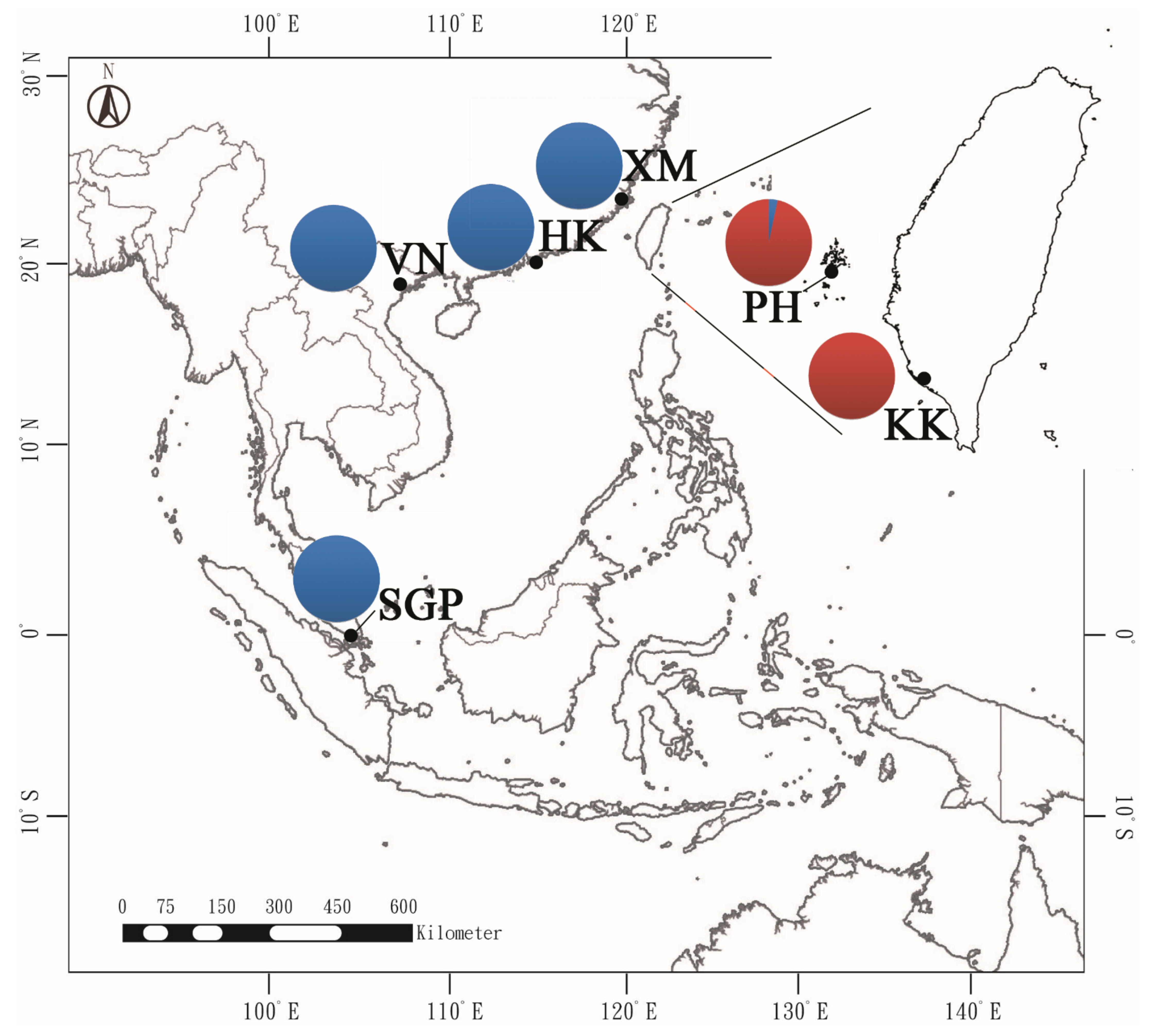
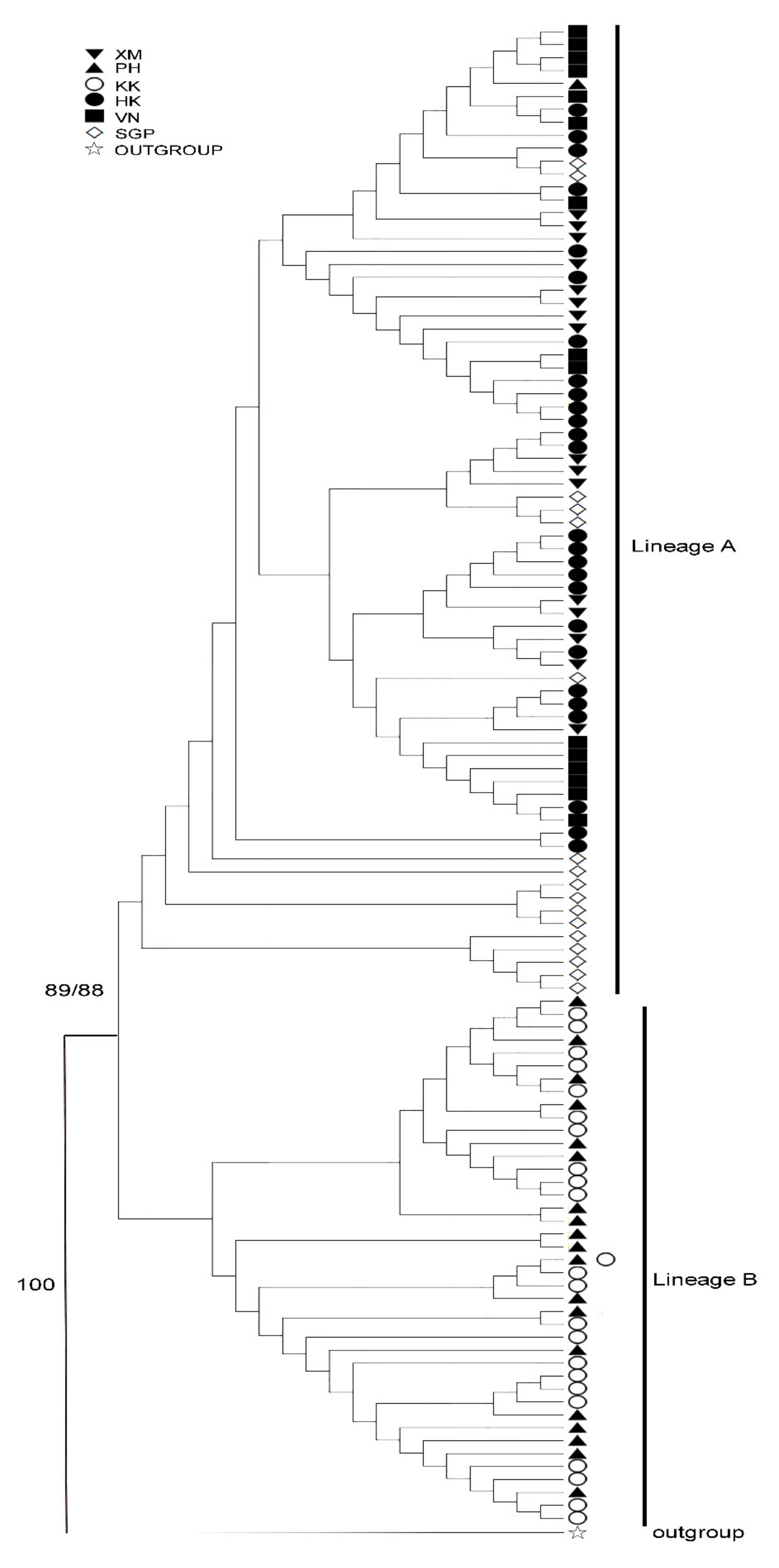
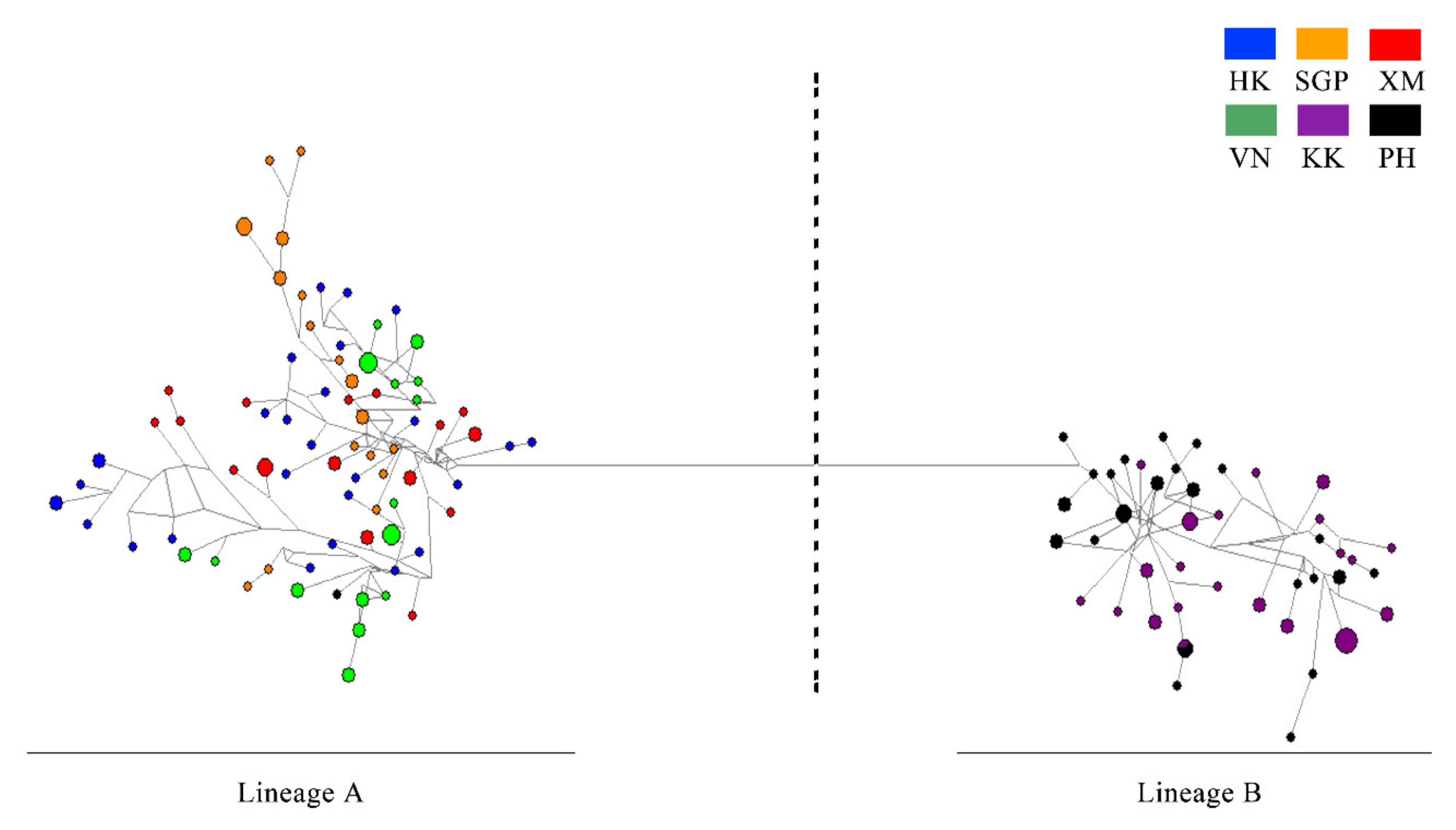
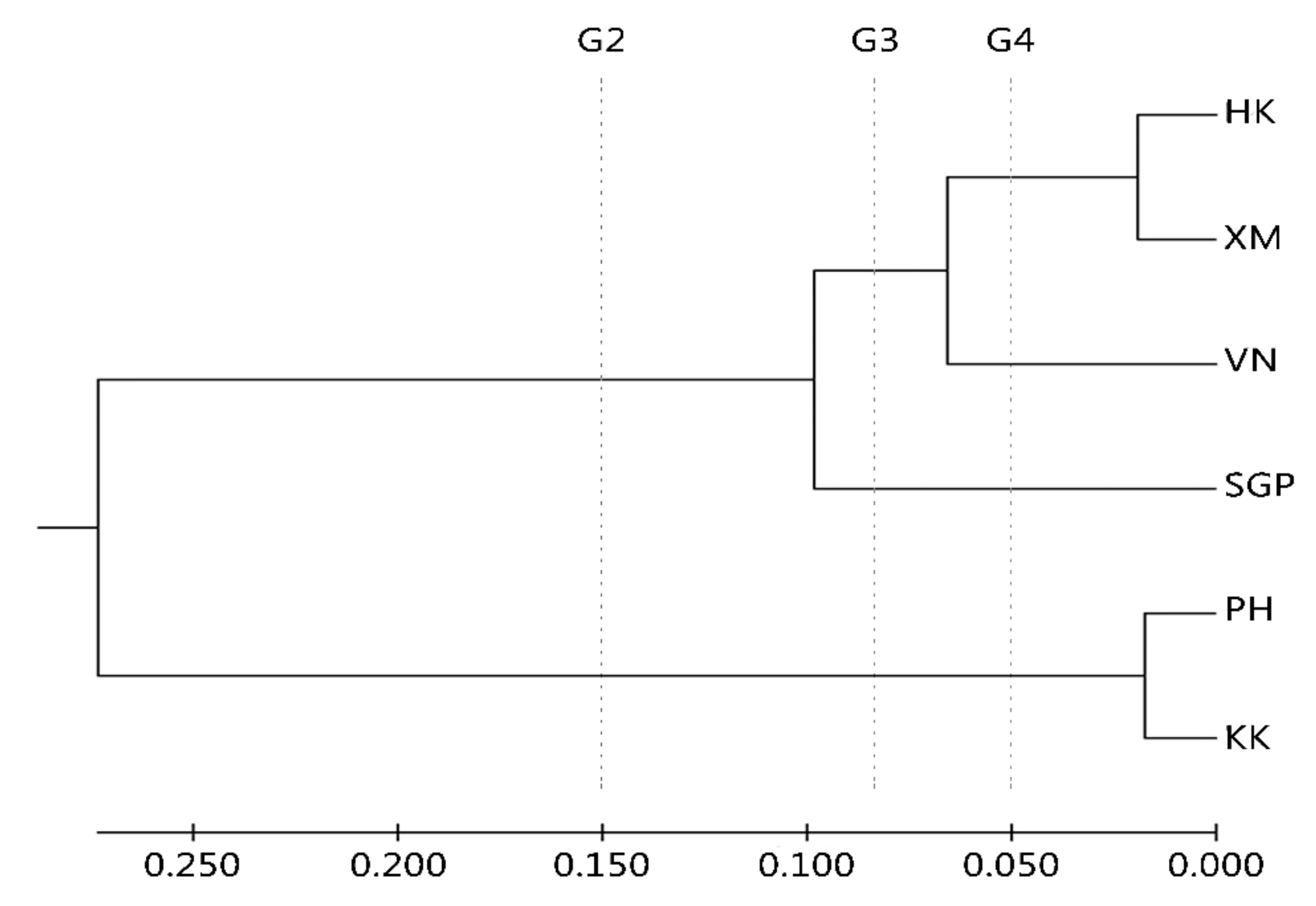
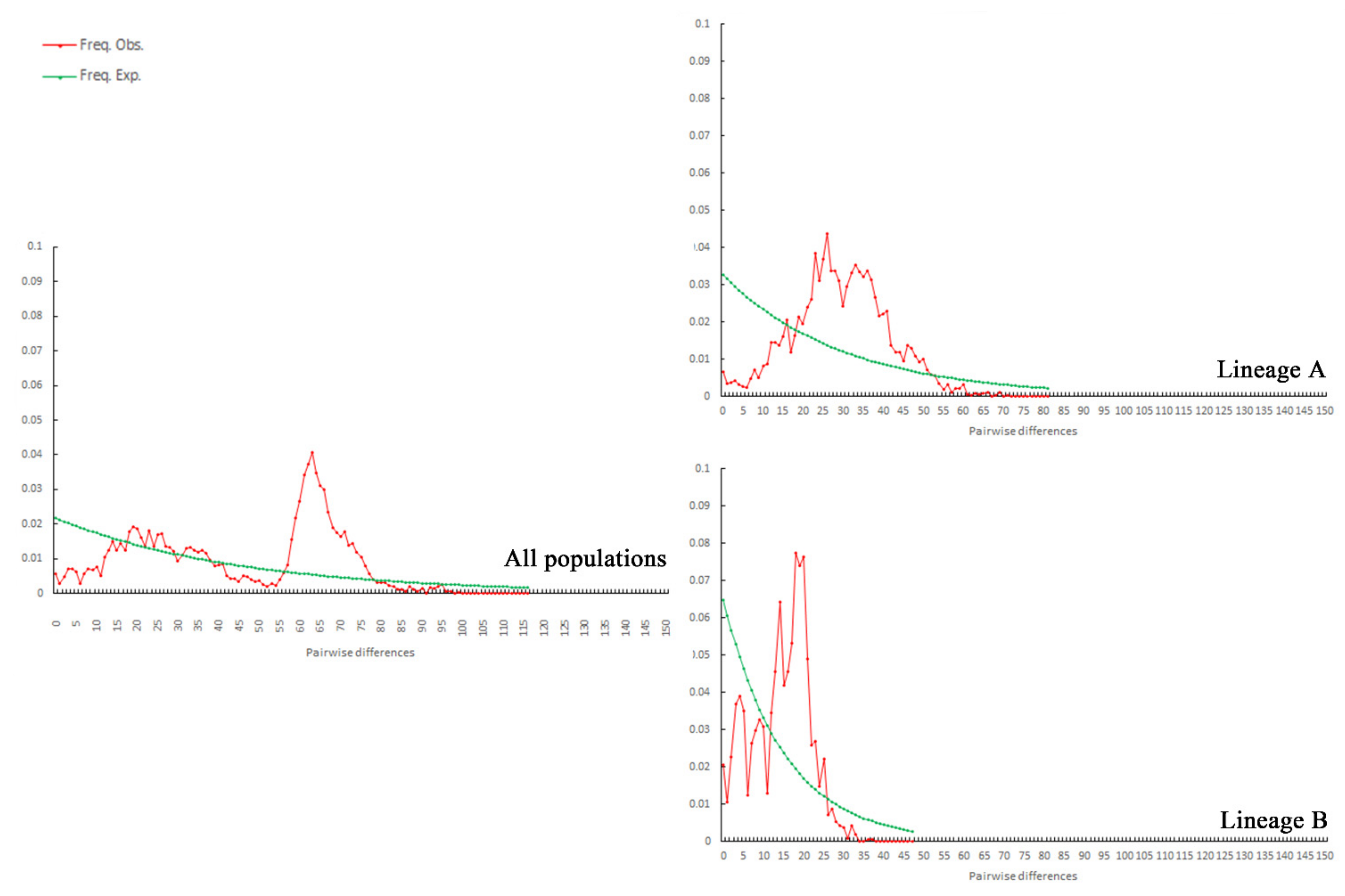
| Population | n | nh | Lineage A | Lineage B | h Diversity | π Diversity | Tajima’s D | Fu’s Fs |
|---|---|---|---|---|---|---|---|---|
| XM | 22 | 16 | 22 | 0 | 0.970 ± 0.022 | 0.045 ± 0.00462 | −0.87197 | 1.271 |
| PH | 30 | 20 | 1 | 29 | 0.961 ± 0.021 | 0.023 ± 0.00431 | −1.53515 | −1.445 |
| KK | 36 | 23 | 0 | 36 | 0.962 ± 0.019 | 0.020 ± 0.00114 | −1.03393 | −2.597 |
| HK | 28 | 26 | 28 | 0 | 0.995 ± 0.011 | 0.046 ± 0.00252 | −1.15632 | −4.889 |
| VN | 27 | 15 | 27 | 0 | 0.949 ± 0.022 | 0.025 ± 0.00194 | 0.5638 | 1.662 |
| SGP | 23 | 17 | 23 | 0 | 0.972 ± 0.020 | 0.032 ± 0.00152 | 0.03936 | −0.197 |
| Lineage A | 101 | 75 | 0.993 ± 0.003 | 0.042 ± 0.00186 | −1.59138 * | −24.23 * | ||
| Lineage B | 65 | 41 | 0.979 ± 0.007 | 0.020 ± 0.00097 | −1.30135 | −11.305 * | ||
| Total | 166 | 116 | 0.994 ± 0.002 | 0.064 ± 0.00120 | −1.0188 | −31.544 * |
| HK | XM | VN | SGP | PH | KK | |
|---|---|---|---|---|---|---|
| HK | - | 0.083 | 0.000 | 0.000 | 0.000 | 0.000 |
| XM | 0.037 | - | 0.000 | 0.000 | 0.000 | 0.000 |
| VN | 0.122 | 0.139 | - | 0.000 | 0.000 | 0.000 |
| SGP | 0.176 | 0.162 | 0.250 | - | 0.000 | 0.000 |
| PH | 0.588 | 0.571 | 0.703 | 0.447 | - | 0.090 |
| KK | 0.532 | 0.514 | 0.629 | 0.389 | 0.035 | - |
| Population | Grouping | Source of Variation | Percentage of Variation | Φ Statistics | p (More Extreme Value) |
|---|---|---|---|---|---|
| One group | Group 1 (HK, XM, VN, SGP, PH, KK) | AP | 41.98 | ΦST = 0.41978 | *** |
| WP | 58.02 | ||||
| Two groups | Group 1 (HK, XM, VN, SGP) | AG | 46.57 | ΦCT = 0.46573 | |
| Group 2 (PH, KK) | AP/WG | 7.07 | ΦSC = 0.13235 | *** | |
| WP | 46.36 | ΦST = 0.53644 | *** | ||
| Three groups | Group 1 (HK, XM, VN) | AG | 44.45 | ΦCT = 0.44445 | * |
| Group 2 (SGP) | AP/WG | 4 | ΦSC = 0.07201 | *** | |
| Group 3 (PH, KK) | WP | 51.55 | ΦST = 0.48446 | *** | |
| Four groups | Group 1 (HK, XM) | AG | 43.42 | ΦCT = 0.43419 | * |
| Group 2 (VN) | AP/WG | 2.13 | ΦSC = 0.03759 | *** | |
| Group 3 (SGP) | WP | 54.45 | ΦST = 0.45546 | *** | |
| Group 4 (PH, KK) |
Publisher’s Note: MDPI stays neutral with regard to jurisdictional claims in published maps and institutional affiliations. |
© 2022 by the authors. Licensee MDPI, Basel, Switzerland. This article is an open access article distributed under the terms and conditions of the Creative Commons Attribution (CC BY) license (https://creativecommons.org/licenses/by/4.0/).
Share and Cite
Lu, Y.-M.; Shih, C.-H.; Chen, P.-C.; Kao, W.-C.; Lee, Y.-C.; Han, Y.-S.; Tzeng, T.-D. Genetic Variations and Expansion of the Blue Swimmer Crab (Portunus pelagicus) in Southeast Asia. J. Mar. Sci. Eng. 2022, 10, 1071. https://doi.org/10.3390/jmse10081071
Lu Y-M, Shih C-H, Chen P-C, Kao W-C, Lee Y-C, Han Y-S, Tzeng T-D. Genetic Variations and Expansion of the Blue Swimmer Crab (Portunus pelagicus) in Southeast Asia. Journal of Marine Science and Engineering. 2022; 10(8):1071. https://doi.org/10.3390/jmse10081071
Chicago/Turabian StyleLu, Yu-Ming, Chun-Han Shih, Po-Cheng Chen, Wei-Chieh Kao, Ying-Chou Lee, Yu-San Han, and Tzong-Der Tzeng. 2022. "Genetic Variations and Expansion of the Blue Swimmer Crab (Portunus pelagicus) in Southeast Asia" Journal of Marine Science and Engineering 10, no. 8: 1071. https://doi.org/10.3390/jmse10081071
APA StyleLu, Y.-M., Shih, C.-H., Chen, P.-C., Kao, W.-C., Lee, Y.-C., Han, Y.-S., & Tzeng, T.-D. (2022). Genetic Variations and Expansion of the Blue Swimmer Crab (Portunus pelagicus) in Southeast Asia. Journal of Marine Science and Engineering, 10(8), 1071. https://doi.org/10.3390/jmse10081071








